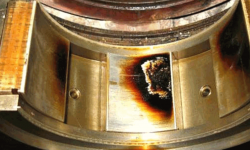ASTM D 7155 - Evaluating Compatibility of Mixtures of Turbine Lubricating Oils is Used as the Guideline for Compatibility Testing
The method calls for two Tiers of testing. For Tier I, the method calls for preparing mixtures of the fluids to be evaluated, heating the fluids and the mixtures in an oven to a specified temperature for 168 hours (7 days). After the heating period, the fluids are removed from the oven and visually inspected for signs of incompatibility, such as loss of clarity or formation of precipitate. If signs of incompatibility are observed, the test can be stopped at this point. If no signs of incompatibility are observed, the fluid mixtures are then cooled for 24 hours. After the cooling period, the fluid mixtures are again observed for signs of incompatibility. If signs of incompatibility are observed, the test can be stopped at this point.
If no signs of incompatibility are observed during Tier I, Tier II testing can then be considered. Tier II is a selection of tests used to compare performance properties of the mixtures and the constituent fluids. Tier II tests should be selected based on the fluids being tested and the application that the fluids will be used in. Possible tests include but are not limited to: Kinematic Viscosity ASTM D445, Acidity ASTM D974, Rust Prevention ASTM D665, Foaming Characteristics ASTM D892, Water Separability ASTM D1401, Oxidation Stability ASTM D2272, Air Release Properties ASTM D3427, Copper Corrosion ASTM D130, and Pentane Insolubles ASTM D893.
Define Your Compatibility Study Needs:
- Decide if you will test your current in-use fluid with the replacement fluid(s). If you have one lubricant system that you are changing to a new oil, testing the used fluid with the replacement fluid is recommended. This will allow any possible incompatibilities between the used oil and new oil due to degradation or contamination to be observed. If you have multiple systems that will be changing to the new oil then comparing a new oil sample of the fluid currently in use in the machines to a new oil sample of the replacement fluid will provide a basic observation of the compatibility of the two fluids. Alternatively, a used oil sample from each of the systems can be tested with the replacement fluid.
- Determine which mixtures you would like tested. ASTM D7155 calls for at least one mixture in the ratio of 50:50. Additional mixtures can be added if appropriate. If you are doing a complete change out, but some residual fluid may be present in the system and could mix with the new fluid then adding a 90% new oil to 10% used oil mixture is recommended. If the replacement fluid will be gradually added to the existing fluid then three mixtures are recommended, either 90:10, 50:50, and 10:90 or 25:75, 50:50, and 75:25.
- Decide upon a testing scheme. You may choose Tier I only or Tier I and Tier II.
- If Tier II will be included, select Tier II tests. Possible tests include Kinematic Viscosity ASTM D445, Acidity ASTM D974, Rust Prevention ASTM D665, Foaming Characteristics ASTM D892, Water Separability ASTM D1401, Oxidation Stability ASTM D2272, Air Release Properties ASTM D3427, Copper Corrosion ASTM D130, and Pentane Insolubles ASTM D893.
To learn more about TestOil's Lubricant Compatibility Analysis click here.






